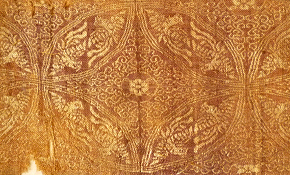| |
 mouse over to magnify mouse over to magnify
| | | | 058 Bali Group, Tenganan
Kamben geringsing, ritual shawl
| | Locale: | Tenganan Pegeringsingan, Bali Aga people. | | Period: | Early 1900s | | Panels: | 1 | | Design: | Geringsing pat likur isi. Black on ecru. Three mandalas, reminders of Indian influence on Hindu Bali, represent sanggar (house temples) and cupu (sources of holy water). Other motifs include asu (dog) and si gading (flower offering). The sanggar motif is near-identical to the lobeng motif found on ikat shawls from Troso Jepara in north-central Java. As the Bali Aga descended from nobles of the East-Javanese Majapahit empire, clearly this pattern was imported by them from their heartland, which covers Troso Jepara near Semarang. | | Size: | 40 x 199 cm (15.7 x 78.3 in) | | Weight: | 123 g (155 g/m2) | | Yarn: | Cotton, hand-spun, fine | | Comment: | Excellent piece of advanced age. A few small holes, as is common for older geringsing, but very good condition overall. The original source most likely is much older than the Majapahit period, witness fragment of a Liao (11th C.) textile from Taiwan or southeast China, below. The central motif here is flanked by phoenixes. Note that ikat was introduced in Nusantara from Taiwan.
 | | Background: | Additional information in chapters on Bali Group and Tenganan. | | Published: | Ikat Textiles of the Indonesian Archipelago, 2018.
| | Compare: | 059 060 | | Sources: | Khan Majlis, Indonesische Textilien, Wege zu Goettern und Ahnen, Fig. 328. Nearly identical piece in Robyn Maxwell, Textiles of Southeast Asia, Fig. 13. Also in Yoshimoto, Ikat, Fig. 3; and in Tropenmuseum No. 1772-1454, depicted in Van Brakel c.s., A Passion for Indonesian Art; as well as in Dawson, Traditional Indonesian Textiles, Fig. 80. | | |
 ©Peter ten Hoopen, 2025
All rights reserved.
|
|


